- Sport & Abenteuer Reisen
- Trekking Reisen
Overview
The Kalindi-Khal Trek is an extremely challenging expedition-style trek, on which we are crossing over the Kalindi Khal Pass in the spectacular Garhwal Himalaya mountains.
This tour should be almost listed under our expeditions!
But it is also a beautiful trek to explore the beautiful mountain state Uttarakhand, which is still a little less explored by international tourists. And you can combine these challenging trek with a few extra days in Rishikesh to practice yoga at the holy place itself!
That trek connects Gangotri and Badrinath- Two of the holiest pilgrimage sites in the mountain state of Uttarakand. The route includes a trek over rough glaciers, rocky moraines and rugged snowfields. But also to idyllic lakes, small villages and beautiful camps. Sometimes we have to abseil down and use ice picks and crampons. The Kalindi-Khal-Trek runs halfway around the Garhwal from the Bhagirathi Valley to the Alaknanda Valley. On the way, the Kalindi Khal offers views of some of the highest and most majestic peaks of the Indian Himalayan Mountains – Shivling at 6,543 m, Meru at 6,630 m, Kedar Dome at 6,808 m, Bhagirathi Group at 6,856 m, Nilkantha at 6,506 m, Chandra Parvat at 6,728 m, Avalanche summit at 6,413 m, Kamet at 7,756 m, Mana at 7,272 m and Abi Gamin at 7,355 m. Although no previous climbing experience is required, this trip is one of our most challenging hikes, suitable only for those who want to take part in an expedition in exploration style.
Program
Day 1 Arrival in Delhi
You will be picked up at the airport and brought to the hotel. Later we go on an exploration tour of Delhi. A dinner together rounds off the day.
Day 2 Delhi to Rishikesh 240 km
Today we take a seven-hour drive to the beginnings of the Himalayas. We will live in the holy city of Rishikesh right on the Ganges. For the next few days we will follow the river to its source.
If you like, you can take part in a yoga class here in the stronghold of yoga.
Day 3 Rishikesh to Uttarkashi (1158 m) 170 km
Even today we spend most of the day in the car. We drive deep into the Himalayas. Arrived in Uttarkashi- Home of our guides- we check the equipment, visit the mountaineering institute and take a short walk to the temple.
Day 4 and 5 Uttarkashi to Gangotri (3400 m) 100 km
Today we go to our trekking starting point Gangotri. The ride will inspire you, as there will be some of the most beautiful views during the trip. Here we will spend a day acclimatizing and also make a sacred ceremony for the success of our trek and the safety of the participants.
Day 6 Gangotri to Bhojwasa (3800 m)
After a healthy breakfast we start our hike towards Bhojwasa, following the river Bhagirathi on the right bank. For the hike we need about 5-6 hours; the distance from Gangotri to Bhojwasa is about 14 km.
Day 7 From Bhojwasa via Gomukh to Tapovan (4463 m)
We get up early in the morning and enjoy the panoramic view of the golden sunrise in the majestic mountains. After a warm, delicious breakfast we head to Gomukh, the source of the gang, and after spending some time there, we continue to Tapovan. The trail leads us through beautiful alpine pastures and green land. We stay at the campsite Tapovan.
Day 8 Tapovan to Nandanvan (4400 m)
We will warm up and stretch a little so that we are ready for hiking with energy throughout the day. We hike over the Gomukh Glacier down to Nandanvan.
Day 9 Nandanvan to Vasuki Valley (4900 m)
After breakfast we start the hike towards the beautiful Vasuki valley. It is a high-altitude glacial lake at an altitude of 14,200 feet. Trekking to this icy lake is an experience for life. The overnight stay takes place in camps on this sparkling lake.
Day 10 Vasuki Valley to Khara Pathar (5400 m)
After an extensive breakfast we start our hike towards Khara Pathar or Suraiaya Bamak, for which we need about 4-5 hours. It is a steep ascent over the moraine for about 5-6 km.
Day 11 Khara Pathar to Sweta Glacier (5500 m)
After breakfast we set off towards Sweta Glacier (5500 m), the trekking distance is about 10-11 km and we will need about 4-5 hours to get there.
Day 12 Sweta Glacier to Base Kalindi Khal Pass (6600 m)
Today’s hike is not the longest at 6 km, but it goes over challenging glacier terrain. We will need our equipment.
Day 13 Base Kalindi Khal to Raja Parav (4910 m)
The day of the pass crossing. Today we make our way over the glacier to the Kalindi Pass (5950 m) and after enjoying the beauty of the landscape and spending some time there, we continue hiking to Raja Parav. More than 1000 hm is to be descended! The overnight stay is in camps.
Day 14 Raja Parav to Arwatal (3980 m)
Today, after breakfast, we head towards The Arwa Tal. The hike to Lake Arwatal is a rewarding experience. The trail is about 13 km long and it will take us about 6-7 hours to get there.
Day 15 Arwatal to Ghastoli (3790 m)
We start our hike towards Ghastoli. The road will be long, about 16 km, and it will take us about 5-6 hours to get there.
Day 16 Ghastoli to Mana and on to Badrinath (3300 m)
After stretching a bit and having a healthy breakfast, we start our trekking and after a 6-7 hour hike we reach the village of Mana, the last village before the border to Nepal. After lunch we continue towards Badrinath, the popular pilgrimage site of hindus.
Day 17 Badrinath to Rishikesh 190 km
We drive from Badrinath back to Rishikesh and say goodbye to the magnificent peaks, bubbling streams and lush green valleys.
Day 18 Rishikesh to Delhi to airport 140 km
Since the international flights usually depart at night. Can we enjoy the morning after in Rishikesh. From here it goes directly to the airport in Delhi.
Services
- Inner Line Permit
- Porter and mountain guide insurance
- Waste fee DFO (Uttarkashi)
- Fee for Gangotri National Park (member, carrier, HAP, cook, helper)
- total transport
- Accommodation in a double room before and after the trek with breakfast
- Dinner together in Delhi
- Travel companion, mountain guide/ Hap (High Altitude Porter)
- Cook + Helper
- Climbing equipment, high mountain tent
- all meals during the trek
- Luggage rack (weight not more than 15 kg)
- Basic first aid
- CLIMBING EQUIPMENT
a. Climbing shoes
b. crampons and gaiters
c. Ice ax
d. Sleeping bag
e. Mattress
International FlightAlcohol, soft drinks, bottled water, drinks, etc.All meals/services not mentioned aboveAny costs incurred by unforeseen circumstances such as landslides, roadblocks, bad weather, etc.Travel insuranceCost of evacuationLaundry, personal medication, personal clothing, tips for wearers and guidesFee for camera / mobile phone cam
Highlights

Kalindi Khal Trek 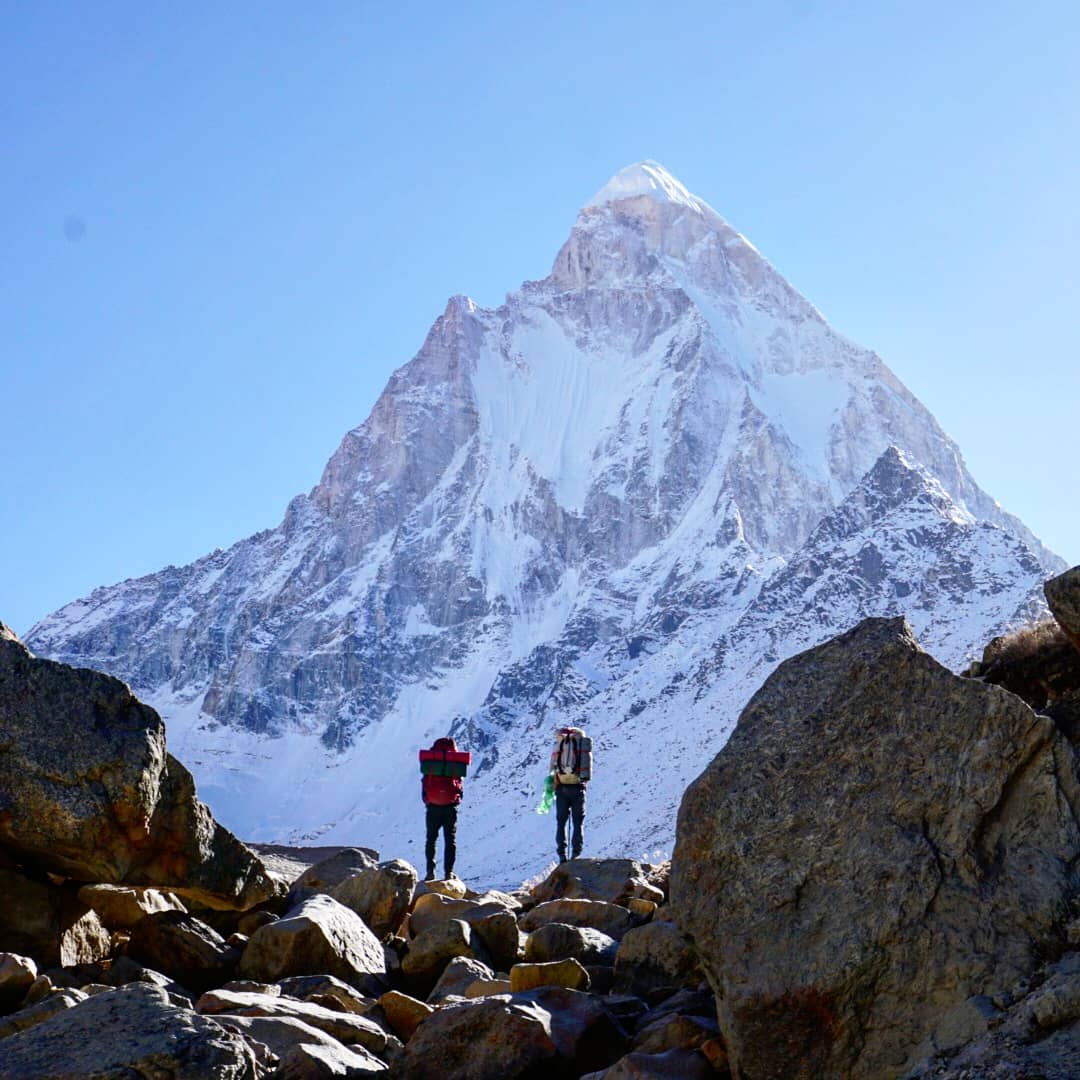
Kalindi Khal Trek 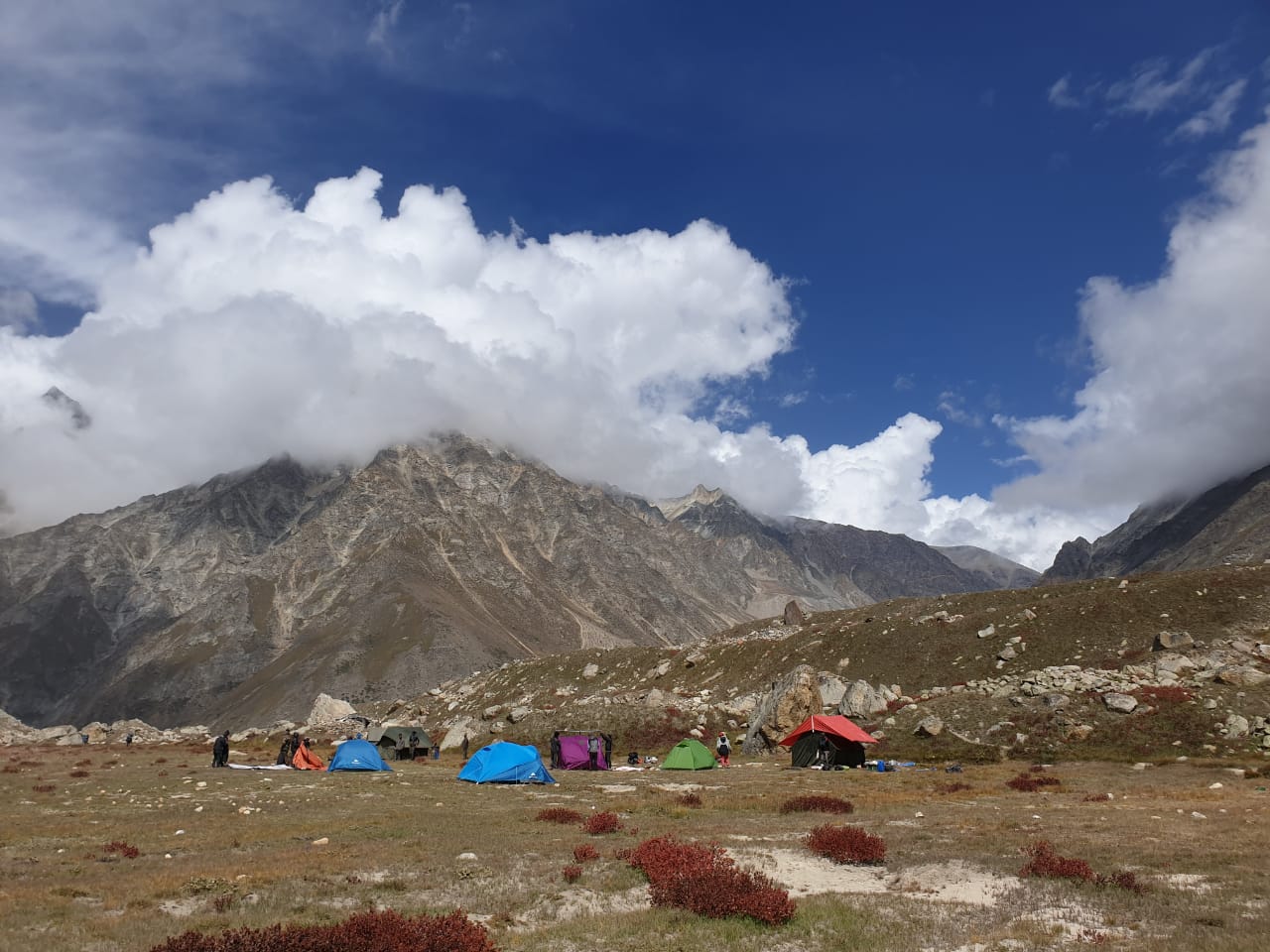
Kalindi Khal Trek 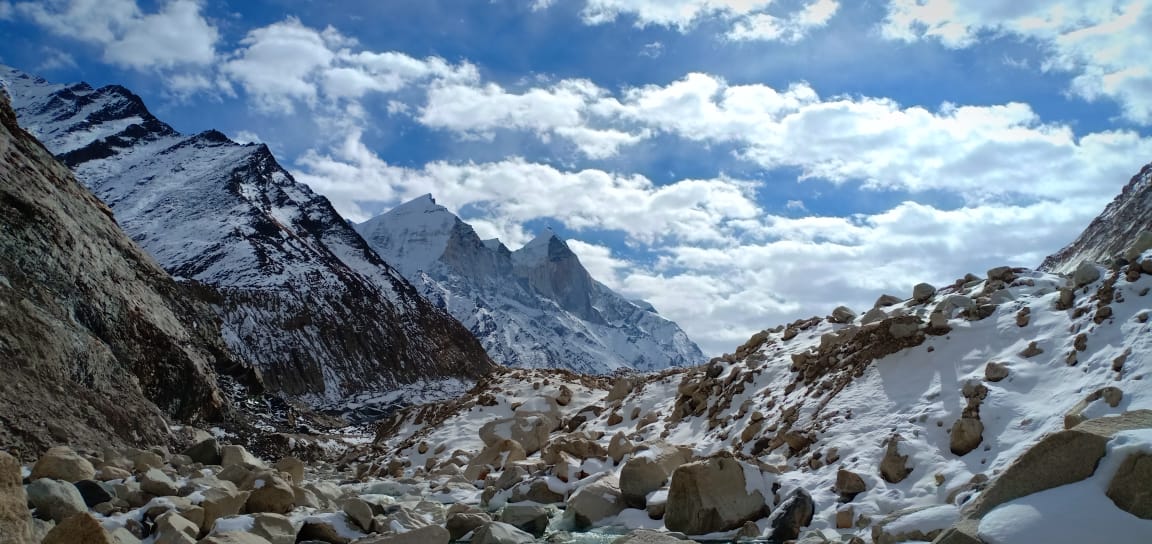
Kalindi Khal Trek 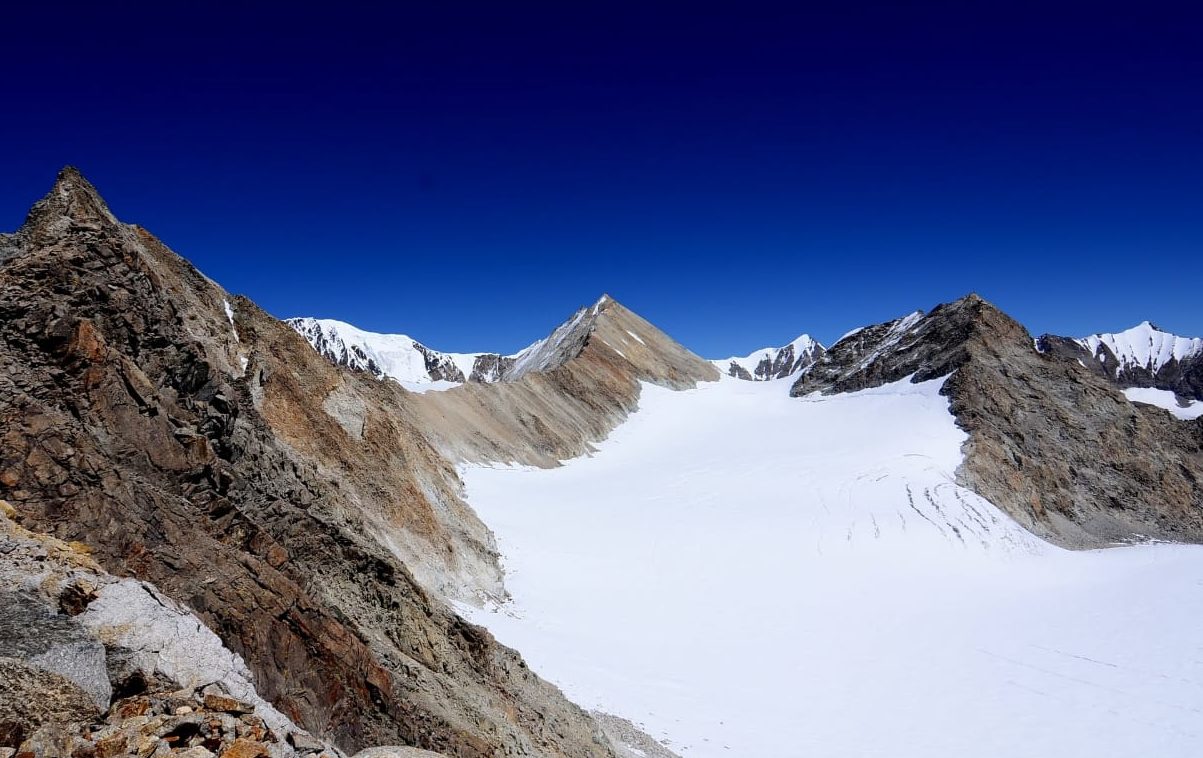
Kalindi Khal Trek 
Kalindi Khal Trek 
Kalindi Khal Trek 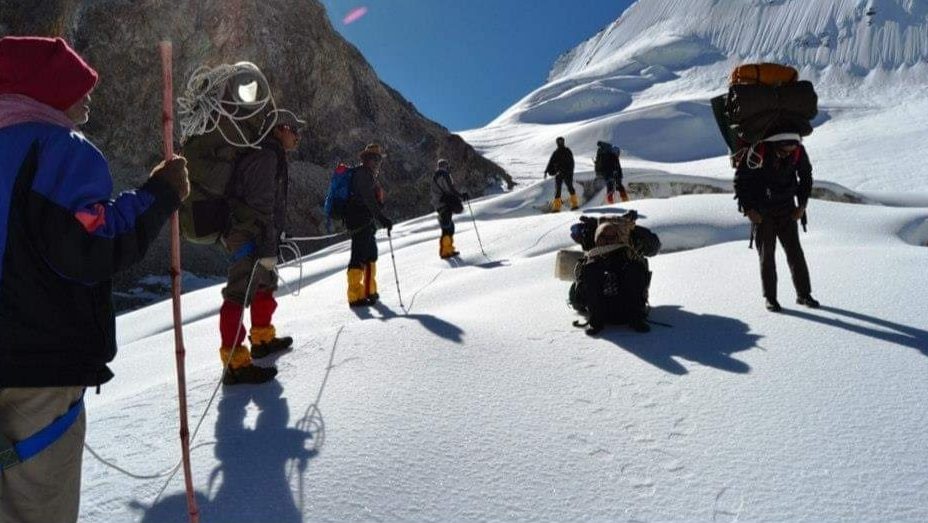
Kalindi Khal Trek 
Kalindi Khal Trek
Prices and Dates
Best time to visit May, June, September, October
For 6 participants 2300 €/person
Carrier for personal luggage at extra charge (approx. 25 €/day)
In case of fewer participants, please make a request
Tour Info
Requirements
The Kalindi Khal is an extremely challenging trek with steep climbs yet adventurous, in the Himalayan region. The trail leads over glaciers, rocky paths and snowfields. It’s a tough and challenging trek, but it rewards with picturesque views of beautiful landscapes and the breathtaking beauty of Mother Nature. The special feature of the trek is that the route halfway around Garhwal leads from the Bhagirathi River Valley to the Alaknanda River Valley. This trip is recommended only for those who already have experience with high mountain treks. This trek is pretty exciting. Even experienced trekkers find it quite challenging and difficult, as some sections on this trek are not for the faint-hearted!
Information about the Trekking Tours with Chalo! Travels
Mountain guide and trekking team
On all our treks we have at least one (for larger groups of 6 participants two) trained local mountain guide. Our mountain guides have all completed at least the Indian mountaineering training, many of them have also completed the advanced courses.
They are familiar with the trekking routes and know the terrain excellently. All our mountain guides speak English.
In addition, there is a local team consisting of a cook (if the group consists of only two participants, the mountain guide also takes over the tasks of the cook), helpers, horsemen with horses or Nepalese porters, depending on the type of trek.
All our team members have been working with us for years, are very friendly and always strive to provide our guests with a great trekking experience. Their English (besides of the Guide) is rather mediocre or non-existent, but this is not necessarily a hindrance to communicating with them.
Trekking routes
The trekking routes are designed according the skills of our guests and are all feasible for a person with a good fitness level, unless otherwise mentioned. The daily routes are between five and eight hours long (with breaks) and an average increase of around 500-800 metres of altitude is completed.
In between, rivers may have to be crossed. The paths are partly well developed, but sometimes also almost non-existent. On our trekking routes there are hardly any villages in between, so we will take enough food for the whole tour.
On our treks we cross passes, snow or glaciers. On steep slopes, we have safety equipment with us.
Daily routine (Depending on the length and intensity of the trek, the times may vary)
7: 00 am Get up with Tea
7:30-8:30 am Breakfast
7:00-9:30 am Dismantling of the camp
8:00- 9:30 am Start Trek
1:00 pm Lunch on the way
3:00-5:00 pm Arrival at the camp and camp construction
3:30-5:30 pm Snacks
7:00 pm Dinner
Altitude and altitude sickness
Altitude sickness is a very important topic that should not be underestimated, especially during our trekking tours in the Indian Himalayas. At altitudes above 3500 m, our body has to slowly get used to the low air pressure, which also causes less oxygen to enter our lungs. The first signs of altitude sickness are headaches, which are accompanied by dizziness, nausea, insomnia and loss of appetite. It becomes problematic when water accumulates in the lungs and brain and edema occurs. Then only the immediate descent to lower altitudes will help. To prepare for the heights on our treks, we will either spend a few nights at high altitudes before the trek or slowly ascend during the trek to acclimatize. If we notice that there are problems with our guests (each person is otherwise able to acclimatize, regardless of age, gender and fitness level), it may happen that either the entire group or the concerned participant descends/returns with a team. In addition, it makes sense to take an emergency drug for altitude sickness. For this, it is best to consult the pharmacy or the travel doctor. For certain treks we will also have oxygen with us.
Luggage
Each trekking participant is responsible for his own clothes and personal belongings. Depending on the trek, we are either with horses or porters. If we have load horses, one bag per participant can be loaded onto the horse. In the case of treks with porters, all personal luggage must be carried independently. Tents, sleeping bags, mattresses and food are carried by our porters.
For trekking tours with horses, a day backpack with space for the lunchbox, a water bottle and warm overcoat clothing should be taken with you. Here to the complete packing list for our trekking tours.
Packing list for trekking tours
- sleeping bag at least -10°C
- large backpack or soft carrying bag so that the load animals can carry the luggage
- Small carrying backpack for the day approx. 30-40 l with rain protection
- flashlight/headlamp
- 2 refillable water bottles
- hiking poles
- passport and passport copy
- camera with spare battery and memory card
- headgear as sun protection
- Good Sunglasses
- cap
- Scarf, Buff
- Gloves
- wind-proof trekking pants
- trekking pants
- Functional Underwear Long
- hiking boots
- socks thick and thin
- sneakers, sandals and/or slats
- windbreaker
- Warm Jacket
- fleece sweater/jacket
- Tshirts
- sunscreen, lip balm min. Protection 40
- fat cream
- water purification tablets (boiled and filtered water is provided)
- own medications for headaches, nausea, digestive problems, colds)
- bubble patches and dressing material
- own hygiene articles
- Toilets Paper
- hand disinfection
Meals
During the trek there will be a vegetarian full catering. Water is either boiled or we have a water filter with us.
Breakfast (daily selection):
- Coffee/Tea
- Oatmeal porridge/muesli/cornflakes/Indian porridge
- Indian breakfast
- Sliced fruit/vegetables
Lunch (mostly lunchbox), sometimes warm in the camp
- Sandwiches/Indian (rice, chapati, vegetables)/potatoes
- Juices
- Chocolate
- Fruit
Snacks
- Tea/coffee
- Cookies
- French fries/Indian snacks
Soup
Dinner (depending on the length of the Trek mix of Indian/Chinese/Continental)
- Vegetable dish
- Lentil dish
- Rice/noodles
- Chapati
- Salad
- Dessert
Accommodation and camp
We have very comfortable and spacious two-man tents. Our mattresses are practical but simple if there are problems with sleeping on hard surfaces, please take your own mattress with you or order from us. Our sleeping bags are freshly washed and have a very good quality with comfort zone up to -5°C/extreme zone up to -20° C. It is recommended to bring personal indoor sleeping bags.
In addition, we have a spacious dining tent with tables and chairs, a kitchen tent for the team and a toilet tent. For treks up to 4 people, the kitchen tent can also act as a dining tent at the same time.
For trekking tours with porters, we will take our smaller, lighter tents with us and do without a toilet tent.
Weather
In the Himalayas, temperatures fluctuate widely. While it can get warm up to 25°C during the day and the sun is not only warming, but also very intense (sun protection is a must), it can also cool down significantly below the minus-grade at night, especially in the months end of September and October, as well as in June. There may also be weather changes with snow on the passes.





